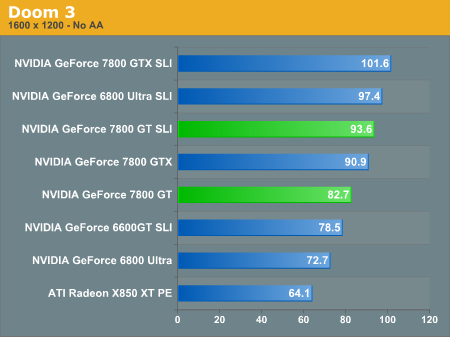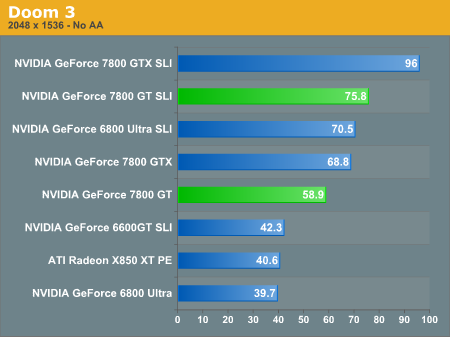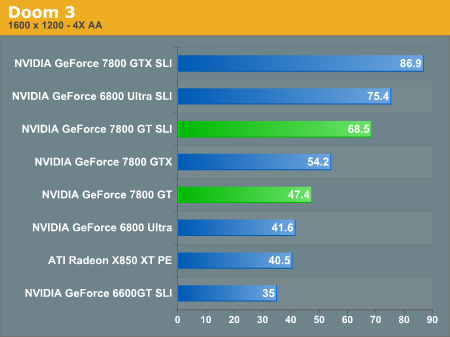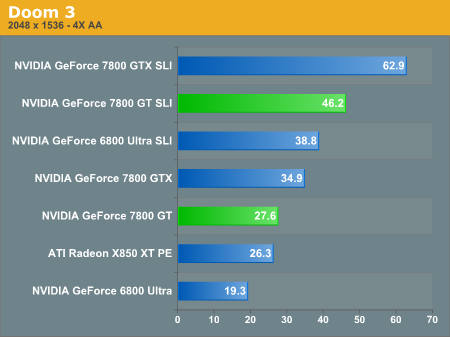NVIDIA GeForce 7800 GT: Rounding Out The High End
by Derek Wilson & Josh Venning on August 11, 2005 12:15 PM EST- Posted in
- GPUs
Doom 3 Performance
One of the most demanding games that we test in terms of graphics, Doom 3 shows some impressive gains. Let's take a look.



We'll start by comparing the 6800 Ultra and the 7800 GT. The most notable increase here is at 2048x1536 with AA enabled, where we see a 43% improvement in fps with the 7800 GT. We get a similar increase (48.4%) at that resolution without AA enabled, but with AA, we went from 19.3 fps, an unplayable framerate, to 27.6, which is borderline-playable. At 1600x1200, both AA and no AA see only about a 14% increase.
As expected, we see higher gains than this when we compare one 6800 Ultra to two in SLI mode. Without AA, the framerates for both resolutions increase by around 30 fps, a 34% increase at 16x12, and a 77.6% increase at 20x15. The gains are even more impressive with AA enabled. 16x12 AA goes from 41.6 to 75.4, an increase of 81.3%; and at 20x15 AA, from 19.3 to 38.8 - an impressive 101% increase.
The gains that we see with the 7800 GT will definitely make a difference in performance with this game, but unfortunately, the GT still struggles at 20x15 with AA enabled. Two 6800Us in SLI mode don't have this problem, and in fact, they handle 20x15 with AA fairly well. This might not matter however, to those who don't care about AA at high resolutions.
It's interesting to note that Doom 3 appears more dependent on GPU memory bandwidth than GPU processing speed, at least in certain scenarios. Notice how the 6800 Ultra SLI configuration actually beats the 7800 GT SLI configuration in several of the tests. The 6800 cards do seem to have more problems with the 20x15 resolution, however.










77 Comments
View All Comments
bob661 - Thursday, August 11, 2005 - link
Forgot all about this. Thanks.
jkostans - Thursday, August 11, 2005 - link
The 9800 pro had to be the best budget investment in all of video card history (as far as I can remember anyways). The price for the 128MB version quickly dropped to below $200 and it was pretty much the top performing card on the market for that price. Now its impossible to find a sub $200 offering that will last for more than 6 months.bob661 - Thursday, August 11, 2005 - link
Same here, sort of. I would LOVE to have a mid range card based on this tech. Running cooler and performing MUCH better than my current setup.
neogodless - Thursday, August 11, 2005 - link
I think what the two of you are missing is that the Geforce 6 series is basically the same technology. This pushes the 6800GT a little closer to mainstream, as it can currently be had for around $250-300, and it will probably drop in the next few months to the $200 level, which is about where it could be considered mainstream (and probably about what you paid for your 6600GT. Any new "mainstream" 7xxx releases would simply overlap current 6xxx parts. If the 7xxx series showed more of a technological difference, then this sort of thing would make more sense. If you go to Nvidia's home page, you'll see their "power of 3" marketing push, and see the list of products that all share this same technology.Lonyo - Thursday, August 11, 2005 - link
Yup.The original request was for "Like a 12-16 pipe/ 256-bit 7600 GT"
Err, the 6800, 6800GT are 12 and 16 pipe, 256bit SM3 cards.
How would a 7600GT type part be ANY different than what we already have, except for being cooler/cheaper to make?
In terms of performance, it's just a case of the 6800 dropping down to cheaper prices.
And as I said in the forums:
"Lower end redesigned parts to replace the 6xxx series would probably use 11nm tech, which would lead to smaller dies, and lower power consumption, reducing heat in the end, and reducing cost to make the die in the first place, making it a better deal for both consumers and nVidia, although transitioning the NV40 to 0.11 might not be worth the hassle."
ie: there's already a current part fitting the niche you want a brand new part for, and the probable only changes would be a transition to a smaller process, and a dropping of the price.
bob661 - Thursday, August 11, 2005 - link
Like I said, I find the cooler/faster combination VERY attractive. I don't care about the 6800GT as it will be warmer/slower than a "7600GT".PrinceGaz - Friday, August 12, 2005 - link
While the 6800GT would be warmer than a hypothetical 16-pipe 7600GT, it would not be slower. On the contrary, the 6800GT would probably be faster. Why? Because it has a 256-bit memory-bus, and in all probability the 7600 series would have a 128-bit bus.The 6800 and 7800 series are designed as high-end parts and for that they need the 256-bit bus to allow satisfactory performance at the extreme resolutions with AA that high-end users demand. The 6600 and possible 7600 are designed as mid-range parts and they do not need to be able to run at such high resolutions with AA, therefore they can make do with a 128-bit bus as memory-bandwidth is not so important at medium resolutions. The 128-bit bus lowers the cost of manufacturing the core, and also the card's circuit board as it is much simplified, and provides a clear distinction between the mid-range and high-end parts.
Do you really think they'd release a 16-pipe 256-bit 7600GT, when the 7800GT is "only" a 20-pipe card? The performance gap would be too narrow. A 12-pipe 256-bit 6600GT would be a possibility, but it would make a lot less sense than a 16-pipe 128-bit 6600GT.
If you want a 16-pipe 256-bit card, just go out and buy a 6800GT. It's every bit as good as the 16-pipe 256-bit 7600GT you want but which will never be released.
PrinceGaz - Friday, August 12, 2005 - link
Ooops the third paragraph should read "Do you really think they'd release a 16-pipe 256-bit 7600GT, when the 7800GT is "only" a 20-pipe card? The performance gap would be too narrow. A 12-pipe 256-bit 7600GT would be a possibility, but it would make a lot less sense than a 16-pipe 128-bit 7600GT."I started calling the 7600GT the 6600GT.
bob661 - Thursday, August 11, 2005 - link
It may be basically the same tech but my 6600GT will never perform like a "7600GT" would. And that's basically what I'm interested in. I don't see why a 7600GT part couldn't be sold at the $200-$220 price point. I'd buy it.neogodless - Thursday, August 11, 2005 - link
Likewise your 6600GT won't perform like a 6800GT... which would perform the same as a 7600GT... the 6800GT will be sold in the $200-$220 price point within six months, and probably sooner.What I might find exciting... would be if ATI actually gets their new card out... and has new mainstream parts (available to buy) that drive down the prices of the X800/X850 and Geforce 6800GT even more, and maybe introduce some new technology, too.
Has anyone heard anything about naming of the new ATI cards? Are they finally ready to give up the Radeon name... or their new X naming? If they went with X900 for the new flagship, would they be able to release new mainstream parts, since there would be nothing to name them?!